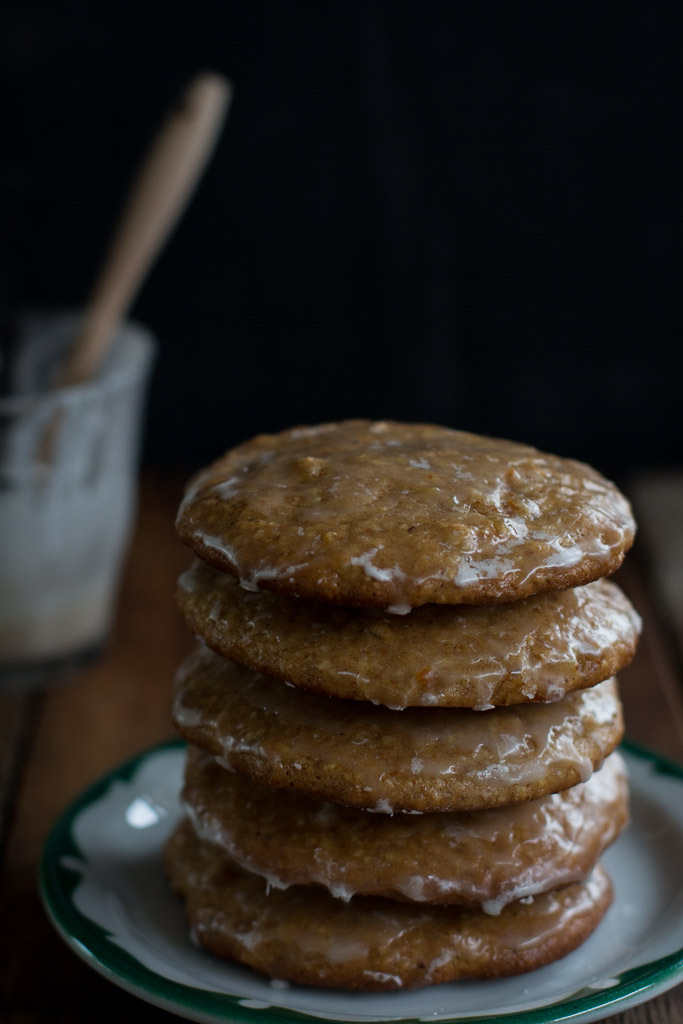The first time I tasted lebkuchen was at a Christmas market in Aachen, Germany. I was studying in Brussels at the time, lounging around on a grey Sunday morning, when my friend, Gösta called. Finding the city insufficiently snowy and festive, he proposed we take a day trip to Germany to experience a traditional Weihnachtsmarkt and some true holiday cheer. I was pretty content under my duvet. But Gösta is Swedish, and so clearly an expert on both snow and holiday cheer. And he was driving. I rallied.
We called two other Swedish friends, Katinka and Joakim, folded ourselves into Gösta’s tiny car and headed out of the city. As we approached the German border, flakes began to fall. By the time we arrived in Aachen, the city and market were as festive and snow-covered as Gösta had predicted.
The market was on a square flanked on all sides by tall, stepped facades that recalled sugared gingerbread houses. Strings of white lights glowed from rooftops. Beneath, there were wooden huts selling hand carved ornaments, dense fruit breads, sprays of holly and twisty peppermint candies. The market smelled of roasting nuts and sizzling wurst, which we ordered with sautéed onions and a smear of spicy German mustard. And there was glühwein, warm mulled wine, that we drank huddled close beneath eaves the eaves.
After the sun had set and the temperature plunged towards truly frigid, we decided it was time to head home. As we wound our way back through the market, we found ourselves on a side-street, in front of a small bakery, its window piled high with German Christmas cookies. Crisp, stamped springerle. Iced cinnamon stars. Humble pfeffernüsse in their jackets of powdered sugar. And another I’d never seen before: pillowy spice cookies emblazoned with blanched almonds and washed with a thin sugar glaze. Lebkuchen. I ordered a heart shaped one, tossed it in my bag and forgot about it.
Excavating my purse several days later, I discovered the slightly smashed cookie. I took a bite. Not only was it still good, it was glorious. Tender. Subtly sweet. Tasting of almonds and honey. And spice. There was cinnamon for sure. And ginger maybe. Something woody and warm like nutmeg or cloves. And something floral like cardamom. And the whole thing was laced through with a ribbon of citrus that kept it from being either too sweet or too dark.
It has been my favorite Christmas cookie ever since.
When I moved back to the U.S., I discovered that almost no one on the West Coast has heard of lebkuchen. So several Christmases ago, I started my search for the perfect recipe. There are many, many versions of lebkuchen. Ones that strive to reproduce the cookie as it existed in 15th-century Nuremberg (the city in which it originated). Unfussy, American versions using molasses and omitting the traditional marzipan, adapted by German immigrants. Fancified modern versions baked as cupcakes and tarts.
I’ve been tinkering with the recipe for several Christmases. This is simply the version that I like best. There are lots of ground almonds to keep the cookie moist. A good hit of spice and a splash of rum to keep things festive. Three forms of citrus--candied peel, zest and juice--for complexity and to balance the dark spices. And this year, having run out of molasses, I made some with sorghum syrup, which produced my best batch yet.
Baking these lebkuchen is a delight in itself. Like all good holiday traditions, it calls to mind cherished friends and family near and far. For me, each bite tastes of a German holiday market and a snowy afternoon spent wandering and laughing and drinking glühwein with good friends.
*A note on ingredients: I prefer sorghum syrup for these cookies, which can be hard to find outside the South. But if you can get your hands on a bottle, its bright sweetness and tart edges will elevate these lebkuchen to some of the finest Christmas cookies around. Light molasses produces great lebkuchen as well. I think dark and blackstrap molasses overwhelm the flavor of the citrus and spice.
Also, I finally found a local source for back oblaten, the thin, edible wafer rounds traditionally used for lebkuchen! If you are in Seattle, you can buy them at PFI. They are also available from specialty sources on the internet. I have made these cookies many times without them, though, and back oblaten are not at all necessary for delicious lebkuchen.
Lebkuchen
- 1 recipe glaze (see below)
- 4 oz candied citrus peel, finely chopped (yields about ¾ cup)
- 2 tablespoons rum, preferably gold or dark
- 7 oz (1 ½ cups) whole almonds
- 7 oz (1 cup) sugar, divided
- 7 oz (1 ½ cup) all-purpose flour
- 1 teaspoon baking powder
- ½ teaspoon kosher salt
- 1 ½ teaspoons cinnamon
- ¼ teaspoon ground ginger
- ¼ teaspoon ground cloves
- ¼ teaspoon ground allspice
- ¼ teaspoon ground cardamom
- 3 large eggs
- ¼ cup light molasses or sorghum syrup
- Zest of ½ lemon
- 13 90mm back oblaten, optional
- ½ cup whole blanched almonds, optional
For glaze:
3 ½ oz (about 1 cup) powdered sugar
1 tablespoon lemon juice
1 tablespoon hot water
Combine the chopped citrus peel and rum in a small bowl. Stir to combine and set aside for at least 15 minutes.
Combine the almonds and 2 tablespoons of the sugar in the bowl of a food processor (a good blender will also work in a pinch). Process until the almonds have been ground to a fine meal.
Transfer the almonds to a medium bowl. Add the flour, baking powder, salt and spices. Stir well to combine.
In a large bowl, beat the eggs with the sugar, molasses or sorghum syrup and lemon zest until foamy. Add the nut mixture and the soaked citrus peel (with any rum in the bottom of the bowl) and stir until just combined. The dough will be quite sticky. Cover with plastic wrap and refrigerate for at least 2 hours and preferably overnight.
Preheat the oven to 375° F.
Using a ¼-cup ice cream scoop, scoop the dough onto a parchment-lined sheet pan, leaving at least an inch between each cookie. If you are using the back oblaten, arrange them on a parchment-lined sheet pan and then scoop the dough into the center of each one. Use your fingers to gently flatten the tops of cookies until they are ½ inch thick (wetting your hands makes this a little easier). If you are using back oblaten, leave a ¼-inch border of wafer around the cookie dough. Place three almonds very close together in the center of each lebkuchen (they spread as the lebkuchen cook). Bake for 15 to 18 minutes, rotating the pans after 12 minutes, until the cookies are set but still soft in the middle. When in doubt, pull them sooner rather than later.
While the lebkuchen are baking, make the glaze: Sift the powdered sugar into a small bowl to remove any lumps. Add the lemon juice and hot water and whisk until smooth.
When the cookies are done, let them cool for a minute or two then transfer to a wire rack set over a parchment-lined sheet pan (to catch glaze drips). Brush the warm lebkuchen with glaze. Repeat if desired. Let the glaze dry completely (an hour or so) before storing.
Store lebkuchen in an airtight container with a small handful of apple peels or a slice of apple or orange. This keeps the cookies moist. The cookies will keep for up to 6 weeks this way and they get better as they age and the spices and citrus oils continue to blend.
Makes a baker's dozen of large (4-inch) cookies







